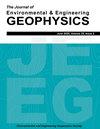Integration of Multi-geophysical Approaches to Identify Potential Pathways of Heavy Metals Contamination - A Case Study in Zeida, Morocco
IF 0.7
4区 工程技术
Q4 ENGINEERING, GEOLOGICAL
引用次数: 5
Abstract
The tailings of Zeida's abandoned mine are found near the city of Midelt, in the middle of the high Moulouya watershed between the Middle and the High Atlas of Morocco. The tailings occupy an area of about 100 ha and are stored either in large mining pit lakes with clay-marl substratum or directly on a heavily fractured granite bedrock. The high contents of lead and arsenic in these tailings have transformed them into sources of pollution that disperse by wind, runoff, and seepage to the aquifer through faults and fractures. In this work, the main goal is to identify the pathways of contaminated water with heavy metals and arsenic to the local aquifers, water ponds, and Moulouya River. For this reason, geophysical surveys including electrical resistivity tomography (ERT), seismic refraction tomography (SRT) and very low-frequency electromagnetic (VLF-EM) methods were carried out over the tailings, and directly on the substratum outside the tailings. The result obtained from combining these methods has shown that pollutants were funneled through fractures, faults, and subsurface paleochannels and contaminated the hydrological system connecting groundwater, ponds, and the river. The ERT profiles have successfully shown the location of fractures, some of which extend throughout the upper formation to depths reaching the granite. The ERT was not successful in identifying fractures directly beneath the tailings due to their low resistivity which inhibits electrical current from propagating deeper. The seismic refraction surveys have provided valuable details on the local geology, and clearly identified the thickness of the tailings and explicitly marked the boundary between the Triassic formation and the granite. It also aided in the identification of paleochannels. The tailings materials were easily identified by both their low resistivity and low P-wave velocity values. Also, both resistivity and seismic velocity values rapidly increased beneath the tailings due to the compaction of the material and lack of moisture and have proven to be effective in identifying the upper limit of the granite. Faults were found to lie along the bottom of paleochannels, which suggest that the locations of these channels were caused by these same faults. The VLF-EM surveys have shown tilt angle anomalies over fractured areas which were also evinced by low resistivity area in ERT profiles. Finally, this study showed that the three geophysical methods were complementary and in good agreement in revealing the pathways of contamination from the tailings to the local aquifer, nearby ponds and Moulouya River.多地球物理方法的整合,以确定重金属污染的潜在途径-在Zeida,摩洛哥的案例研究
Zeida废弃矿山的尾矿在Midelt市附近被发现,位于摩洛哥中部和高阿特拉斯之间的高Moulouya分水岭的中间。尾矿占地约100公顷,要么储存在有粘土泥灰岩底的大型矿坑湖中,要么直接储存在严重断裂的花岗岩基岩上。这些尾矿中铅和砷的高含量已经将它们转化为污染源,通过风、径流和断层和裂缝渗透到含水层。在这项工作中,主要目标是确定含有重金属和砷的污染水进入当地含水层、池塘和穆卢亚河的途径。为此,在尾矿库上进行了电阻率层析成像(ERT)、地震折射层析成像(SRT)和甚低频电磁(VLF-EM)等地球物理测量,并直接对尾矿库外的基底进行了测量。综合这些方法得到的结果表明,污染物通过裂缝、断层和地下古河道汇集,污染了连接地下水、池塘和河流的水文系统。ERT剖面成功地显示了裂缝的位置,其中一些裂缝延伸到整个上部地层,一直延伸到花岗岩深处。ERT不能成功识别尾矿正下方的裂缝,因为它们的电阻率很低,阻碍了电流向深处传播。地震折射测量提供了有价值的当地地质资料,明确了尾矿的厚度,明确了三叠纪组与花岗岩的界线。它还有助于古河道的识别。尾矿材料具有低电阻率和低纵波速度特征,易于识别。此外,由于物料的压实和水分的缺乏,在尾矿下电阻率和地震速度值迅速增加,并已被证明是识别花岗岩上限的有效方法。在古河道的底部发现了断裂,表明这些河道的位置是由这些断裂造成的。VLF-EM测量显示了裂缝区域的倾角异常,这在ERT剖面的低电阻率区域也得到了证实。最后,研究表明,三种地球物理方法在揭示尾矿对当地含水层、附近池塘和穆罗亚河的污染途径方面具有互补性和一致性。
本文章由计算机程序翻译,如有差异,请以英文原文为准。
求助全文
约1分钟内获得全文
求助全文
来源期刊

Journal of Environmental and Engineering Geophysics
地学-地球化学与地球物理
CiteScore
2.70
自引率
0.00%
发文量
13
审稿时长
6 months
期刊介绍:
The JEEG (ISSN 1083-1363) is the peer-reviewed journal of the Environmental and Engineering Geophysical Society (EEGS). JEEG welcomes manuscripts on new developments in near-surface geophysics applied to environmental, engineering, and mining issues, as well as novel near-surface geophysics case histories and descriptions of new hardware aimed at the near-surface geophysics community.
 求助内容:
求助内容: 应助结果提醒方式:
应助结果提醒方式:


